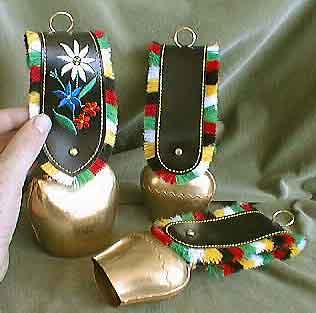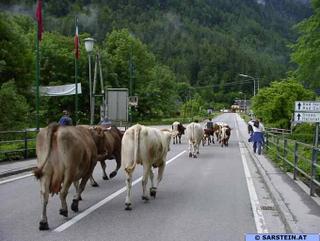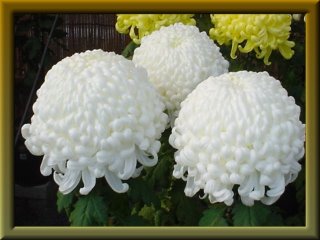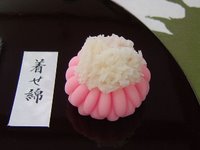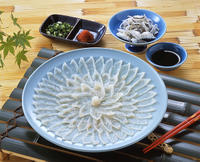. Legends about ox, bull, cow . . .
:::::::::::::::::::::::::::::::::::::::::::::::::::::::::::::::::::::::::::::::::::::::::::::::::::::
Cow, Bull, Ox (ushi)
***** Location: Japan, other areas
***** Season: various, see below
***** Category: Animal
*****************************
Explanation
The Cow, the Holy Cow in India, the ox-headed deities of various cultures .. this is a vast field, click on the photo to read more:

:::::::::::::::::::::::::::::::::::::::::::::::::::::::::::::::::::::::::::::::::::::::::::::::::::::
QUOTE:
India's majority Hindu community reveres cowsand considers them to be "second mothers" .
About 8,000 years ago, the relationship between cows and man began with the revolutionary advent of domestication in Mesopotamia, the Indus River Valley, and Africa. There were many possible candidates for the job but only the cow fit the specific criteria humankind needed: not too flighty, breeds well in captivity, grows at a good pace, not aggressive, requires a low maintenance diet.
Our ancestors chose wisely: Cows provide just about all of our basic needs, from milk and meat to muscle.
http://www.pbs.org/wnet/nature/holycow/
oooooooooooooooooooooooooooooooooooooo

Paint the Holy Cow.com
:::::::::::::::::::::::::::::::::::::::::::::::::::::::::::::::::::::::::::::::::::::::::::::::::::::
Now let us look at some Japanese kigo with this animal.
:::::::::::::::::::::::::::::::::::::::::::::::::::::::::::::::::::::::::::::::::::::::::::::::::::::
... ... ... Spring
Late Spring
Bullfighting, toogyuu 闘牛 Togyu
bulls fighting, ushi zumoo 牛角力
getting the bulls together, ushi awase 牛合わせ
getting the horns to clash, ushi no tsuno tsuki 牛の角突き
Different from Spain, the bulls are fighting each other, with the horns clashing and then driving the opponent out of the ring, like the SUMO wrestling of the humans. Each bull is accompanied by a farmer who sees that the animals do not really hurt each other.
Farmers keep these bulls in their home like pets and winners are named like in human SUMO wrestling, yokozuna, and so on.
Some areas in Japan are especially famous for these fights, for example Uwajima, Hachjoo-Jima, Oki no Shima. In other areas, fighting of dogs is performed instead.
These fights are held during late sprint to early summer. They still remind us of times when bulls and cows where the necessary animals to help farmers with their daily work in the fields.
. Fighting Bull Toys 闘牛玩具 .
:::::::::::::::::::::::::::::::::::::::::::::::::::::::::::::::::::::::::::::::::::::::::::::::::::::
... ... ... Summer
cooling cows and horses, gyuuba hiyasu 牛馬冷す
cooling cows, ushi hiyasu 牛冷す
cooling horses, uma hiyasu 馬冷す
cool cow, hiyashi ushi 冷やし牛
cool horse, hiyashi uma 冷やし馬
washing cows, ushi arau 牛洗う
washing horses, uma arau 馬洗う
These are all kigo for late summer, they refer to a custom during the Gion Festival on the 25th day of the 6th month according to the old Asian calendar.
Cows and horses drawing the carts for the festival were driven down to the river and washed to cool down. Their legs were cooled, then the whole body, whith the people around them taking a cooling dip too. It was a time for merrymaking after a hot day.
Farmers would also cool their animals after working during a hot summer day. So this kigo expressed the kind care of farmers toward their animals, many considered as children of the house. Lately, this custsom has become sparse, as horses and cows are replaced by maschinery.
. ushi no Gion 牛の祗園(うしのぎおん)"Gion of the Bull"
Gion Festival
kigo for late summer
.................................................................................
Kigo for early summer.
takaki ushi 田掻牛(たかきうし)cow/bull for light plowing
..... shiro ushi 代牛(しろうし)
Farmers work in Summer
.................................................................................
observance kigo for late summer.
Bull Ritual, ushi kuyoo 牛供養
great field planting ritual, ootaue 大田植え
hayashida 囃田(はやしだ)"planting with music"

hana taue 花田植 (はなたうえ) "planting in the flower season"
In some areas of Western Japan, especially Tottori, Hiroshima, Shimane and Yamaguchi it is customary to plant a big field (oota) at the beginning of the rice planting season. Cows and bulls are decorated and walk through the fields in a colorful parade, with music acompanyment. Then girls in traditional robes plant the big field.
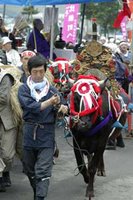
Look at more photos here
http://homepage.mac.com/motoiaraki/hiba2/taue2.html
:::::::::::::::::::::::::::::::::::::::::::::::::::::::::::::::::::::::::::::::::::::::::::::::::::::
observance kigo for late autumn
Bull Festival, ushi matsuri 牛祭
Bull Festival of Uzumasa, 太秦の牛祭 Uzumasa no ushi matsuri
Uzumasa ushimatsuri 太秦牛祭(うずまさうしまつり
God Madara, matara jin 摩多羅神
This is a Buddist festival for the Deity Matarajin. The God appears riding on the black cow. It is held in Kyoto on the 12th of October at the temple Kooryuu-Ji (Koryuji 広隆寺). The temple is also called "Uzumasa Temple" うずまさでら【太秦寺】.
Matarajin, Madarajin (Matara Shin) a protector of the Amida Sutra
and the Korean Connetion to the Hata clan 秦氏
By Gabi Greve

Copyright TANAKA MASAAKI All right reserved.
Look at more prints of festivals by Tanaka san.
http://www.masaakitanaka.co.jp/english/kyoto.htm
:::::::::::::::::::::::::::::::::::::::::::::::::::::::::::::::::::::::::::::::::::::::::::::::::::::
. Cow nose ring ritual (hanaguri kuyoo)
memorial ceremony for the cows 牛魂供養
third saturday in April. Okayama prefecture
*****************************
Worldwide use
India
Cow (Pashu, Gai) ... The Holy Cow of India
Bull Fighting, jallikattu
Bull-taming at the Pongal Festival,
kigo for spring in India

Jallikattu is a wild bull taming sport played in Tamil Nadu as a part of Pongal celebration. Although it sounds similar to the Spanish running of the bulls, it is quite different. In Jallikattu, the bull is not killed and the 'matadors' are not supposed to use any weapon. It is held in the villages of Tamil Nadu on the eve of Mattu Pongal, one of the four days of Pongal festival (usually January 15 on the Western calendar). The one held in Alanganallur, near Madurai, is the most popular. This sport is also known as "Manju Virattu", meaning "chasing the bull".
In Jallikattu, an agitated bull is set to run in an open space. Several people, empty handed, try to tame it by controlling its horns. The winner gets a prize, which is generally tied to the horns of the bull. Only men take part in this game. Sometimes, more than one bull is loose at the same time. The village farmers take this game as a display of their masculine strength. Betting is also common during the game.
According to legend, in olden days the game was used by women to choose their husbands. Successful "matadors" were chosen as grooms.
There are several rock paintings, more than 3,500 years old, at remote Karikkiyur village in the Nilgiris district in Tamil Nadu that show men chasing bulls.
© More in the WIKIPEDIA !
*****************************
Things found on the way
The first day of doyoo in midsummer (and midwinter) is called
ushi no hi, 牛の日、the day of the ox,
as in the 12 signs of the Japanese zodiac.
Read more here: Dog Days (doyoo) in Japan
:::::::::::::::::::::::::::::::::::::::::::::::::::::::::::::::::::::::::::::::::::::::::::::::::::::
Go-Oo Hooin 牛王宝印 sacred seal of the ox treasure
goou hooin, 牛玉宝印 (くまのごおうほういん)from Kumano
熊野山宝印, 那智瀧宝印, 烏牛王 "crow and ox treasure"
. Amulets from Kumano .
The sacred seal of the ox treasure is also issued at the temple Senso-Ji at the Asakusa Kannon.
January 5 牛玉加持会
Prayer Ritual for the Deity of the Ox

source : www.senso-ji.jp/annual_event
. WKD : Asakusa Kannon 浅草観音 .
*****************************
HAIKU
- - - - - Kobayashi Issa - - - - -
A sudden shower falls -
and naked I am riding
on a naked horse!
Tr. Lucien Stryk
Summer shower -
naked horse
naked rider.
Tr. Lucien Stryk
. . . . . .
夕立や裸で乗しはだか馬
yuudachi ya hadaka de norishi hadaka uma
rainstorm--
a naked rider
on a naked horse
Tr. David Lanoue
(I guess the rider is wearing a fundoshi (kind of underwear) at least.)
... ... ... ... ...
Issa and the Horse Shit - 馬糞山
with a lovely haiga by Nakamura Sakuo
.................................................................................
牛の子が旅に立也秋の雨
ushi no ko ga tabi ni tatsu nari aki no ame
the calf begins
his journey...
autumn rain
Tr. David Lanoue
.................................................................................
on the pass two days --
牛の汗あらし木がらし吹にけり
ushi no ase arashi kogarashi fuki ni keri
high winds
cold gusts stripping
sweat off cows
Tr. Chris Drake
This hokku was written by Issa as he made his way over high Usui Pass on the eastern border of his mountainous home province of Shinano at the end of the 10th month (November) in 1807. Earlier that year he'd returned to his hometown to negotiate with his half-brother about their father's will but had made no progress, so he decided to make another trip for the same purpose. Winter is deepening, however, and there is a windstorm (arashi) blowing in the mountain range he has to cross. Soon the storm becomes a full-blown early winter gale (kogarashi) with strong gusts, and it seems to have taken two days for him to make the crossing. The cows seem to be in a high pasture on a small plateau below the pass, and they struggle to stand in the same place without getting blown away.
When Issa reached his hometown on 11/5, his reception didn't differ much from what he experienced at the pass:
yuki no hi ya furusato-bito mo bu-ashirai
in my hometown
greeted by snow
and by people, too
Four days later he left his hometown as homeless as ever, and after visiting some local haikai poets he returned to Edo.
Chris Drake
. WKD : Usui Pass 薄井の峠 .
. Kobayashi Issa 小林一茶 in Edo .
*****************************
SENRYU
牛方のあきらめて行く俄雨
ushikata no akiramete yuku niwaka ame
the cow leader
havs given up and walks
in the sudden rain
The cows do not care about rain and do not walk faster, so their masters have to trodd along with them when leading them to work.

. senryu, senryū 川柳 Senryu in Edo .
*****************************
Related words
***** Cow (Pashu, Gai) The Holy Cow of India
***** Running of the Bulls (El Encierro) SPAIN
***** World Kigo Database: Cowbells
***** World Kigo Database: Star Festival (Tanabata)
. Folk Toys and Talismans with the Cow .
丑 / 牛 ushi
. WASHOKU : Beef dishes of Japan
. Legends about ox, bull, cow . . .
:::::::::::::::::::::::::::::::::::::::::::::::::::::::::::::::::::::::::::::::::::::::::::::::::::::
. Lipstick made in the cold (kanbeni, ushibeni)
and its history in Edo
:::::::::::::::::::::::::::::::::::::::::::::::::::::::::::::::::::::::::::::::::::::::::::::::::::::::
[ . BACK to DARUMA MUSEUM TOP . ]
[ . BACK to WORLDKIGO . TOP . ]
- #ushi #ox #bull #cow -
:::::::::::::::::::::::::::::::::::::::::::::::::::::::::::::::::::::::::::::::::::::::::::::::::::::::
